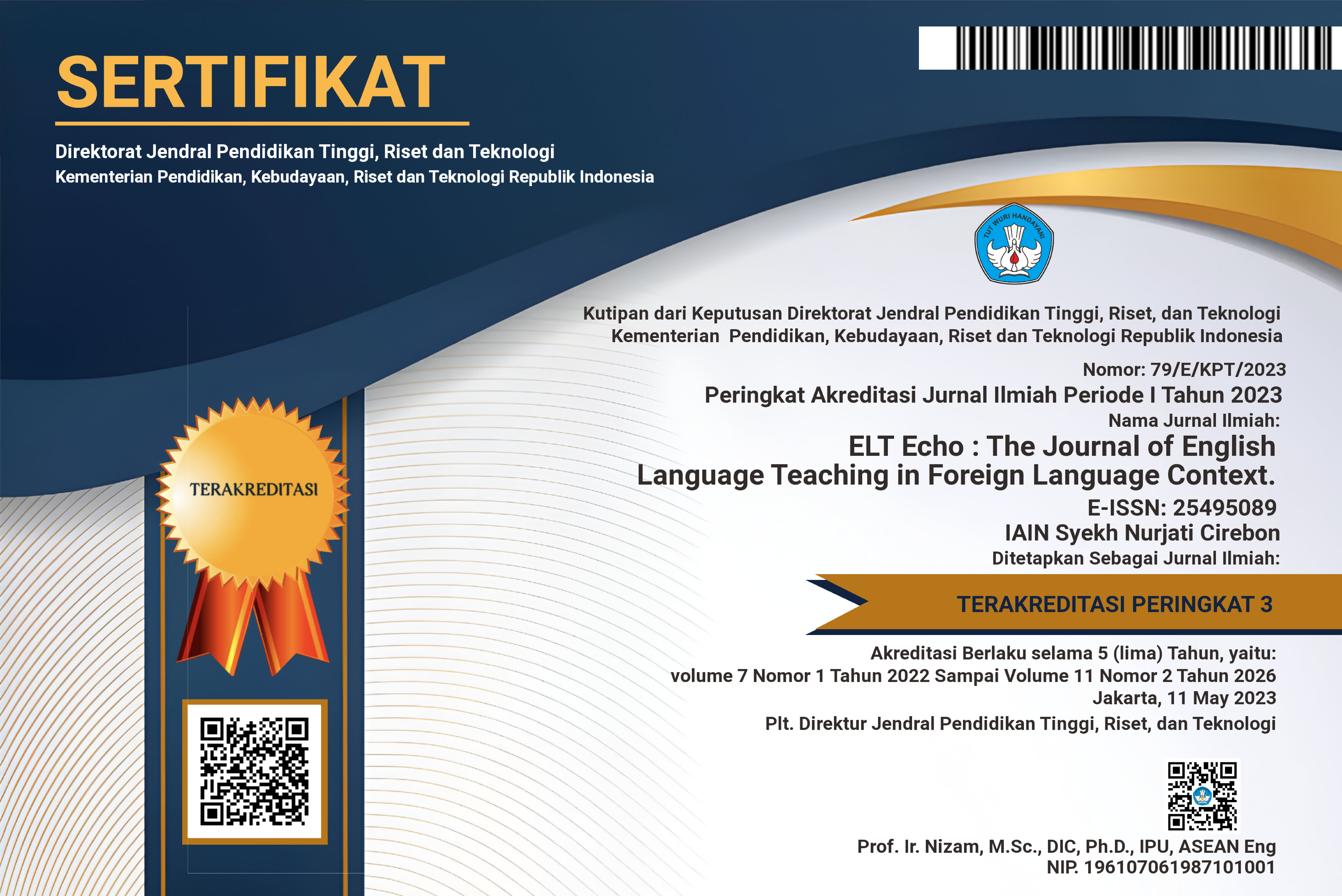RHIZOMATIC EXPLORATIONS OF PRE-SERVICE EFL TEACHERS IN THE TEACHING PRACTICUM
(1) IAIN Syekh Nurjati Cirebon
(*) Corresponding Author
Abstract
Keywords
References
Achadiyah, R., & Azmi, M. U. (2024). Perception and problem of English pre-service teachers in applying Merdeka Belajar curriculum during teaching practice. Journal of English Education Program, 5(1). https://doi.org/10.26418/jeep.v5i1.71757
Aldabbus, S. (2018). Project-based learning: Implementation & challenges. International Journal of Education, Learning and Development, 6(3), 71–79. www.eajournals.org
Creswell, J. W. (2017). Research design: Qualitative, quantitative, and mixed methods approaches. Sage publications.
de Freitas, E. (2012). The classroom as rhizome: New strategies for diagramming knotted interactions. Qualitative Inquiry, 18(7), 557–570. https://doi.org/10.1177/1077800412450155
Deleuze, G., & Guattari, F. (1987). A thousand plateaus: Capitalism and schizophrenia. University of Minnesota Press.
Ellen, K. K., & Sudimantara, L. B. (2023). Examining Emancipated curriculum development in middle schools: A case study. PANYONARA: Journal of English Education, 5(2), 165–188. https://doi.org/10.19105/panyonara.v5i2.8779
Fletcher, S. J., & Mullen, C. A. (2012). Mentoring and coaching in education the SAGE handbook of mentoring and coaching in education. SAGE Publications.
Genç, Z. S. (2016). More practice for pre-service teachers and more theory for in-service teachers of English language. Procedia - Social and Behavioral Sciences, 232, 677–683. https://doi.org/10.1016/j.sbspro.2016.10.092
Hordvik, M., Fletcher, T., Haugen, A. L., Møller, L., & Engebretsen, B. (2021). Using collaborative self-study and rhizomatics to explore the ongoing nature of becoming teacher educators. Teaching and Teacher Education, 101. https://doi.org/10.1016/j.tate.2021.103318
Hordvik, M., MacPhail, A., & Ronglan, L. T. (2019). Negotiating the complexity of teaching: a rhizomatic consideration of pre-service teachers’ school placement experiences. Physical Education and Sport Pedagogy, 24(5), 447–462. https://doi.org/10.1080/17408989.2019.1623189
Hordvik, M., MacPhail, A., & Ronglan, L. T. (2020). Developing a pedagogy of teacher education using self-study: A rhizomatic examination of negotiating learning and practice. Teaching and Teacher Education, 88. https://doi.org/10.1016/j.tate.2019.102969
Kabilan, M. K. (2013). A phenomenological study of an international teaching practicum: Pre-service teachers’ experiences of professional development. Teaching and Teacher Education, 36, 198–209. https://doi.org/10.1016/j.tate.2013.07.013
Kemendikbudristek. (2022, February 25). Kenali 3 Opsi Ini Sebelum Mendaftar Implementasi Kurikulum Merdeka Jalur Mandiri. https://ditsmp.kemdikbud.go.id/kenali-3-opsi-ini-sebelum-mendaftar-implementasi-kurikulum-merdeka-jalur-mandiri/
Kounios, J., & Beeman, M. (2014). The cognitive neuroscience of insight. Annual Review of Psychology, 65, 71–93. https://doi.org/10.1146/annurev-psych-010213-115154
Kraft, M. A., Blazar, D., & Hogan, D. (2018). The Effect of Teacher Coaching on Instruction and Achievement: A Meta-Analysis of the Causal Evidence. Review of Educational Research, 88(4), 547–588. https://doi.org/10.3102/0034654318759268
Kumaravadivelu, B. (2012). Language teacher education for a global society: A modular model for knowing, analyzing, recognizing, doing, and seeing language teacher education for a global society. Routledge. www.routledge.com/education
Leander, K. M., & Rowe, D. W. (2006). Mapping literacy spaces in motion: A rhizomatic analysis of a classroom literacy performance. Reading Research Quarterly, 41(4), 428–460. https://doi.org/10.1598/rrq.41.4.2
Lian, A. P. (2004). Technology-enhanced language learning environments: A rhizomatic approach. Computer-Assisted Language Learning: Concepts, Contexts and Practices, 1–20.
Lian, A. P. (2011). Reflections on language-learning in the 21st century: The rhizome at work. Journal of Current Science and Technology, 1(1), 5–16. http://academicearth.org
Lian, A. P., & Pineda, M. V. (2014). Rhizomatic learning: “As… when… and if…” A strategy for the ASEAN community in the 21st century. Beyond Words, 2(1), 1–28.
Peercy, M. M. (2012). Problematizing the theory-practice gap: How ESL teachers make sense of their preservice education. Eğitimde Kuram ve Uygulama, 8(1), 20–40.
Mani, P. (2010, August). Aha! Moments. Science Reporter, 29–31.
Masny, D. (2017). Rhizoanalysis as educational research. In M. A. Peters (Ed.), Encyclopedia of educational philosophy and theory (pp. 2043–2048). Springer.
Mishra, P., & Koehler, M. J. (2008). Introducing technological pedagogical content knowledge. Annual Meeting of the American Educational Research Association, 1, 16.
Mudra, H. (2018). Pre-service EFL teachers’ experiences in teaching practicum in rural schools in Indonesia. Qualitative Report, 23(2), 319–344. https://doi.org/10.46743/2160-3715/2018.3115
Mustapa, K., Suciati, I., & Mailili, W. H. (2024). Impact of implementing the competency-based Merdeka curriculum in secondary education on enhancing 21st century skills and meeting the demands of the competitive job market. International Journal of Teaching and Learning (INJOTEL), 2(1), 165–178.
Mutmainah, A., & Widhiatama, D. A. (2024). Unveiling success: Exploring strategies of pre-service teachers in implementing Merdeka curriculum in Indonesia. Asian Journal of Applied Education (AJAE), 3(1), 23–42. https://doi.org/10.55927/ajae.v3i1.7833
Nugraha, T. S. (2022). Kurikulum Merdeka untuk pemulihan krisis pembelajaran. Inovasi Kurikulum, 19(2), 251–262. https://doi.org/10.17509/jik.v19i2.45301
Ovens, A., Garbett, D., & Hutchinson, D. (2016). Becoming teacher: Exploring the transition from student to teacher. In International Handbook of Teacher Education: Volume 2 (pp. 353–378). Springer Singapore. https://doi.org/10.1007/978-981-10-0369-1_10
Rohmah, Z., Hamamah, H., Junining, E., Ilma, A., & Rochastuti, L. A. (2024). Schools’ support in the implementation of the Emancipated Curriculum in secondary schools in Indonesia. Cogent Education, 11(1). https://doi.org/10.1080/2331186X.2023.2300182
Rutherford, V., Conway, P. F., & Murphy, R. (2015). Looking like a teacher: Fashioning an embodied identity through dressage. Teaching Education, 26(3), 325–339. https://doi.org/10.1080/10476210.2014.997699
Scanlon, D., MacPhail, A., & Calderón, A. (2022). A rhizomatic exploration of a professional development non-linear approach to learning and teaching: Two teachers’ learning journeys in “becoming different.” Teaching and Teacher Education, 115, 103730. https://doi.org/10.1016/j.tate.2022.103730
Strom, K. J. (2014). Becoming-teacher: The negotiation of teaching practice of first-year secondary science teachers prepared in a hybrid urban teacher education program. Montclair State University.
Strom, K. J. (2015). Teaching as assemblage: Negotiating learning and practice in the first year of teaching. Journal of Teacher Education, 66(4), 321–333. https://doi.org/10.1177/0022487115589990
Sudimantara, L. B. (2023). Perspectives and experiences of Indonesian pre-service English teachers in developing digital learning resources. English Review: Journal of English Education, 11(3), 609–628. https://doi.org/10.25134/erjee.v11i3.7919
Supartinah, S., Prananto, I. W., Kawuryan, S. P., Hastomo, A., & Senen, A. (2023). Assistance in the adoption of the kurikulum Merdeka at Elementary School 1 Padokan Yogyakarta. Jurnal Pengabdian UNDIKMA, 4(2), 299. https://doi.org/10.33394/jpu.v4i2.7071
Waterhouse, M. (2008). Experiences of multiple literacies and peace: A rhizoanalysis of becoming in immigrant language classrooms.
Wulandari, Y., S, R., & Ilham, D. (2024). Unleashing student creativity. International Journal of Asian Education, 5(1), 21–33. https://doi.org/10.46966/ijae.v5i1.371
DOI: 10.24235/eltecho.v10i1.21040
Article Metrics
Abstract view : 1 timesRefbacks
- There are currently no refbacks.
Â
This Journal is indexed by:
Â

This work is licensed under a Creative Commons Attribution 4.0 International License.










